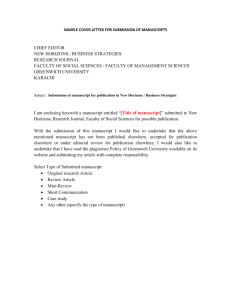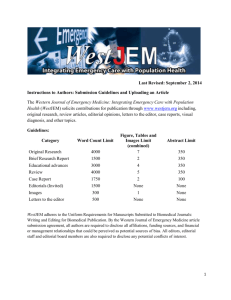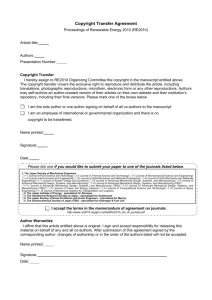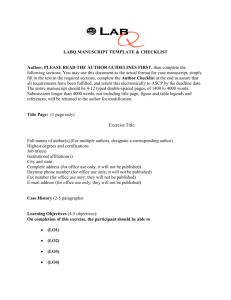Partner Article
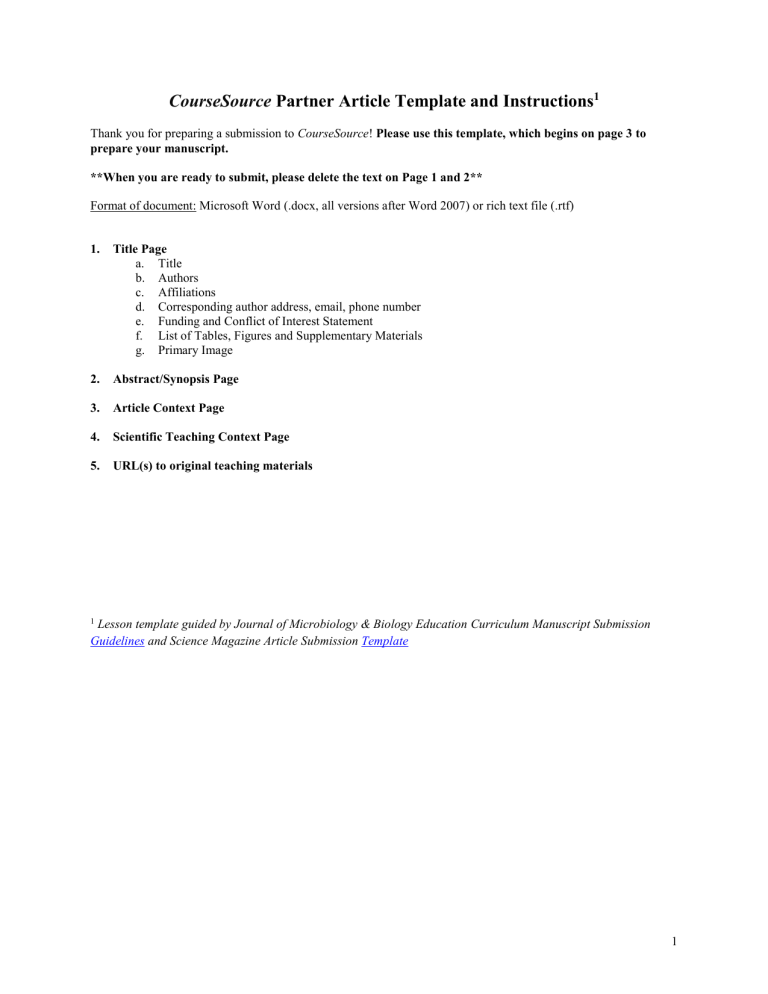
CourseSource Partner Article Template and Instructions
1
Thank you for preparing a submission to CourseSource ! Please use this template, which begins on page 3 to prepare your manuscript.
**When you are ready to submit, please delete the text on Page 1 and 2**
Format of document: Microsoft Word (.docx, all versions after Word 2007) or rich text file (.rtf)
1.
Title Page a.
Title b.
Authors c.
Affiliations d.
Corresponding author address, email, phone number e.
Funding and Conflict of Interest Statement f.
List of Tables, Figures and Supplementary Materials g.
Primary Image
2.
Abstract/Synopsis Page
3.
Article Context Page
4.
Scientific Teaching Context Page
5.
URL(s) to original teaching materials
1 Lesson template guided by Journal of Microbiology & Biology Education Curriculum Manuscript Submission
Guidelines and Science Magazine Article Submission Template
1
MANUSCRIPT SUBMISSION CHECKLIST
Please use this checklist after completing your manuscript, (please also delete this page just prior to submission): o Authors and affiliations listed o Corresponding author identified and address listed o Funding and Conflict of Interest Statement included o List of Figures, Tables and Supplemental Materials included o Primary Image included o Abstract/Synopsis included o Learning Goals composed correctly and clearly relate to Lesson o Learning Objectives composed correctly and clearly relate to Lesson o Scientific Teaching Context included o Active Learning addressed o Assessment addressed o Inclusive Teaching addressed
2
Partner Article Title: Write your title here
Write the author list here as a single paragraph.
List authors by first name (optional middle initial or middle name) followed by last name.
Separate multiple authors by commas.
Use superscript numbers to link authors to specific affiliations, and symbols *,†,†† for author notes (such as corresponding author).
For example, First Middle Last 1 *, First Last 2 †, and First M. Last 1
Affiliations:
1 Precede each affiliation by a superscript number corresponding to the author list; end each affiliation with a period.
2 Each affiliation should be in a separate paragraph.
*Correspondence to: the corresponding author(s) should be indicated with an asterisk; include the postal mail and email addresses of the corresponding author(s).
†Additional author notes should be indicated with symbols (for example, for current addresses, type of contribution, etc.).
Type of Manuscript: CourseSource Partner Article
Funding & Conflict of Interest Statement: Sources of outside support for the creation of the resource must be named in the contributed manuscript. If funding is related to a potential conflict of interest, include the funding information here. Conflict of interest exists when an author, reviewer or editor has financial, personal, or professional relationships that could inappropriately bias or compromise his or her actions. The presence OR absence of perceived conflicts must be addressed on a Conflict of Interest Notification on the manuscript’s title page.
List of Supplemental Material: Please list the Supplemental materials (if any) associated with the article.
Title and Description of Primary Image: We ask that an image be submitted with the manuscript that represents the information in the article (e.g. a picture of a dividing cell for a Lesson about mitosis or a picture taken of students doing the activity). This image will be displayed with the title of your article on the CourseSource website. If you do not have a primary image, the editorial staff will select one that best fits your article. Please be conscientious of the copyright associated with any image used in your Lesson!
3
Abstract Page
The abstract should be a single paragraph of 250 words or less. Start with an opening sentence that sets the teaching challenge that you address in this manuscript, provide background information specific to this Lesson, briefly description the Lesson, and end with a concluding sentence.
For Partner Articles that are published on other journals, please provide a brief synopsis that will enable a reader to determine whether they want to click on the link to the original article.
4
Article Context Page
: To make the submission process easier, you may want to fill out the following form, (you will be asked to select answers during the submission process). Choose all applicable options that effectively describe the conditions IN WHICH THE LESSON WAS
TAUGHT . Modifications to expand the usability of the Lesson will be addressed later in the text.
**Please delete this page prior to submission.
**Not all categories will pertain to your article, in those cases, please select ‘NA’ when submitting on the website.
Course o Biochemistry o Cell Biology o Developmental Biology o Genetics o Microbiology o Molecular Biology o Introductory Biology o Bioinformatics o Evolution o Ecology o Anatomy-Physiology o Neurobiology o Plant Biology o Science Process Skills
Course Level o Introductory o Upper Level o Graduate o High School o Other
Class Type o Lecture o Lab o Seminar o Discussion Section o On-line o Other
Audience o Life Sciences Major o Non-Life Science Major o Non-Traditional Student o 2-year College o 4-year College o University o Other
Class Size o 1 – 50 o 51 – 100 o 101+
Assessment Type o Assessment of individual student performance o Assessment of student groups/teams o Assignment o Exam/quiz, in class o Exam/quiz, take home o Homework o Answer clicker-type question(s) o Answer essay question(s) o Answer fill in the blank question(s) o Answer multiple choice question(s) o Answer short answer questions(s) o Answer true/false question(s) o Create a concept map o Create a diagram, drawing, figure, etc. o Create a website o Create graph, table etc. to present data o Design an experiment or research study o Design/present a poster o Give an oral presentation o Informal in-class report o Interpret data o Order items (e.g. strip sequence) o Participate in discussion o Peer evaluation o Post-test o Pre-test o Produce a video or video response o Respond to metacognition/reflection prompt o Self evaluation o Solve problem(s) o Written assignment: One minute paper o Written assignment: Brochure o Written assignment: Essay o Written assignment: Figure and or figure legend o Written assignment: Lab report o Written assignment: Literature review o Other
5
Lesson Length o Portion of one class period o One class period o Multiple class periods o One term (semester or quarter) o One year o Other
Key Scientific Process Skills o Reading research papers o Reviewing prior research o Asking a question o Formulating hypotheses o Designing/conducting experiments o Predicting outcomes o Gathering data/making observations o Analyzing data o Interpreting results/data o Displaying/modeling results/data o Communicating results
Pedagogical Approaches o Think-Pair-Share o Brainstorming o Case Study o Clicker Question o Collaborative Work o One Minute Paper o Reflective Writing o Concept Maps o Strip Sequence o Computer Model o Physical Model o Interactive Lecture o Pre/Post Questions o Other
Bloom’s Cognitive Level (based on learning objectives & assessments) o Foundational: factual knowledge & comprehension o Application & Analysis o Synthesis/Evaluation/Creation
Principles of how people learn o Motivates student to learn material o Focuses student on the material to be learned o Develops supportive community of learners o Leverages differences among learners o Reveals prior knowledge o Requires student to do the bulk of the work
Vision and Change Core Concepts o Evolution o Structure and Function o Information flow, exchange and storage o Pathways and transformations of energy and matter o Systems
Vision and Change Core Competencies o Ability to apply the process of science o Ability to use quantitative reasoning o Ability to use modeling and simulation o Ability to tap into the interdisciplinary nature of science o Ability to communicate and collaborate with other disciplines o Ability to understand the relationship between science and society
Key Words: List 3 – 10 key words that are relevant for the Lesson (e.g. mitosis; meiosis; reproduction; egg; etc.) o o o o o o o o o
6
o
Scientific Teaching Context Page
Learning Goal(s): Provide clearly stated learning goals, which are broad statements of what the students will know once they have completed the Lesson. Learning goals are typically rather abstract and use words like “know,” “understand”, “appreciate,” or “demonstrate”.
For example:
Students will understand the steps in mitosis.
Students will appreciate the importance of mitosis in the process of reproduction.
Learning Objective(s): Define what students who have successfully accomplished the learning goal can actually do. Learning objectives describe student behaviors that are observable, measurable, and testable. Learning objectives should test students’ mastery of the material and use words like
“define”, “predict”, “design” and “evaluate.”
For example:
Compare and contrast mitosis and meiosis.
Predict consequences of abnormal meiosis.
2. Scientific Teaching Themes: Explain how the Lesson relates to the Scientific Teaching Themes of:
Active Learning: How will students actively engage in learning the concepts? List and/or explain the active learning strategies that are used in the Lesson. For example, activities could include think-pair-share, clicker questions, group discussion, debate, etc. Include both inclass and out-of-class activities.
Assessment: How will teachers measure learning? How will students self-evaluate their learning? List and/or explain the kinds of assessment tools used to measure how well students achieved the learning objectives. For example, assessments might be clicker questions, forced choice questions, exams, posters, etc.
Inclusive Teaching: How is the Lesson designed to include all participants and acknowledge the value of diversity in science? List and/or explain how the Lesson is inclusive and how it leverages diversity in the classroom and beyond. For example, the lesson may use multiple senses and provide examples of scientists from different backgrounds.
7
Supplemental Materials Files
Title supplemental materials as follows:
1.
“Supplemental File S1, S2,” etc.,
2.
Short version of your article title (so that readers can easily tell which article a supplemental material is from)
3.
followed by the filename and extension
See examples below.
** Wherever possible, ensure that the article title and authors are visible when a reader opens the file, either in a header, on the first page/first slide, or as a “Notes” sheet in a workbook of spreadsheets.
Examples:
Supplemental File S1: Why Meiosis Matters-PowerPoint with Lecture Presentation Slides.docx
Supplemental File S2: Bad Cell Reception-Assignment Worksheet.doc
Supplemental File S3: Teaching PCR Demonstration video showing how multi-colored yarn was used to model supercoiled, chromosomal DNA.mov
8

